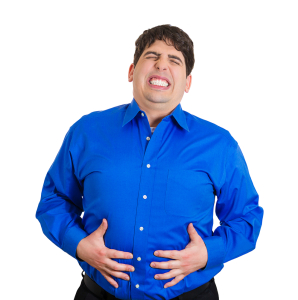The main symptoms of acute pancreatitis are severe abdominal pain, which is of a piercing nature and rapid weight loss.
In about half of the cases the pain irradiates right through into the back. There is a tendency of pancreatitis due to gall stones to develop within hours or 1 to 2 days. Acute pancreatitis due to alcohol seems to develop more gradually over days, if not weeks. However, there are many exceptions to this.
Once the pain is present, it is so severe that it requires large amounts of narcotics to control it. The pain stays usually for several days. It is best handled with meperidine (Demerol) injections, as morphine contracts the sphincter of Oddi, the valve that controls the opening of the pancreatic duct and the common bile duct as it connects to the duodenum. However, Demerol relaxes that sphincter.
Obstructed bile flow
If a gall stone is caught there it would obstruct the bile flow and the pancreatic juice flow simultaneously thus producing both cholecystitis and acute pancreatitis. There may be jaundice as well. As pancreatitis is so excruciatingly painful, the patient might not be aware that there might be two conditions at the same time. The moment the gall stone passes, things usually settle down fairly quickly for the cholangitis and also in a few days for the pancreatitis. Other symptoms are vomiting, and dry heaves, rapid breathing, a fever, confusion and loss of consciousness in severe cases. About 1 in 5 patients with pancreatitis will notice an upper abdominal distension or severe bloating.
Inflammatory secretions around the pancreas
This originates from severe inflammatory secretions around the pancreas which can push the stomach forward and that can be seen as a bulge and felt as a rigidity in the upper abdomen, when the physician examines. Such cases must be observed very carefully as they are possibly the ones that will lead to complications. The surrounding tissues can be directly affected by the lytic enzymes from the pancreatic juice, which can eat its way through any tissue into the abdominal cavity or through veins into the circulatory system leading to shock and sepsis. Such patients are extremely sick and belong into the Intensive Care Unit (ICU).
References
1. M Frevel Aliment Pharmacol Ther 2000 Sep (9): 1151-1157.
2. M Candelli et al. Panminerva Med 2000 Mar 42(1): 55-59.
3. LA Thomas et al. Gastroenterology 2000 Sep 119(3): 806-815.
4. R Tritapepe et al. Panminerva Med 1999 Sep 41(3): 243-246.
5. The Merck Manual, 7th edition, by M. H. Beers et al., Whitehouse Station, N.J., 1999. Chapters 20,23, 26.
6. EJ Simchuk et al. Am J Surg 2000 May 179(5):352-355.
7. G Uomo et al. Ann Ital Chir 2000 Jan/Feb 71(1): 17-21.
8. PG Lankisch et al. Int J Pancreatol 1999 Dec 26(3): 131-136.
9. HB Cook et al. J Gastroenterol Hepatol 2000 Sep 15(9): 1032-1036.
10. W Dickey et al. Am J Gastroenterol 2000 March 95(3): 712-714.
11. M Hummel et al. Diabetologia 2000 Aug 43(8): 1005-1011.
12. DG Bowen et al. Dig Dis Sci 2000 Sep 45(9):1810-1813.
13. The Merck Manual, 7th edition, by M. H. Beers et al., Whitehouse Station, N.J., 1999.Chapter 31, page 311.
14. O Punyabati et al. Indian J Gastroenterol 2000 Jul/Sep 19(3):122-125.
15. S Blomhoff et al. Dig Dis Sci 2000 Jun 45(6): 1160-1165.
16. M Camilleri et al. J Am Geriatr Soc 2000 Sep 48(9):1142-1150.
17. MJ Smith et al. J R Coll Physicians Lond 2000 Sep/Oct 34(5): 448-451.
More references
18. YA Saito et al. Am J Gastroenterol 2000 Oct 95(10): 2816-2824.
19. M Camilleri Am J Med 1999 Nov 107(5A): 27S-32S.
20. CM Prather et al. Gastroenterology 2000 Mar 118(3): 463-468.
21. MJ Farthing : Baillieres Best Pract Res Clin Gastroenterol 1999 Oct 13(3): 461-471.
22. D Heresbach et al. Eur Cytokine Netw 1999 Mar 10(1): 7-15.
23. BE Sands et al. Gastroenterology 1999 Jul 117(1):58-64.
24. B Greenwood-Van Meerveld et al.Lab invest 2000 Aug 80(8):1269-1280.
25. GR Hill et al. Blood 2000 May 1;95(9): 2754-2759.
26. RB Stein et al. Drug Saf 2000 Nov 23(5):429-448.
27. JM Wagner et al. JAMA 1996 Nov 20;276 (19): 1589-1594.
28. James Chin, M.D. Control of Communicable Diseases Manual. 17th ed., American Public Health Association, 2000.
29. The Merck Manual, 7th edition, by M. H. Beers et al., Whitehouse Station, N.J., 1999. Chapter 157, page1181.
30. Textbook of Primary Care Medicine, 3rd ed., Copyright © 2001 Mosby, Inc., pages 976-983: “Chapter 107 – Acute Abdomen and Common Surgical Abdominal Problems”.
31. Marx: Rosen’s Emergency Medicine: Concepts and Clinical Practice, 5th ed., Copyright © 2002 Mosby, Inc. , p. 185:”Abdominal pain”.
32. Feldman: Sleisenger & Fordtran’s Gastrointestinal and Liver Disease, 7th ed., Copyright © 2002 Elsevier, p. 71: “Chapter 4 – Abdominal Pain, Including the Acute Abdomen”.
33. Ferri: Ferri’s Clinical Advisor: Instant Diagnosis and Treatment, 2004 ed., Copyright © 2004 Mosby, Inc.







